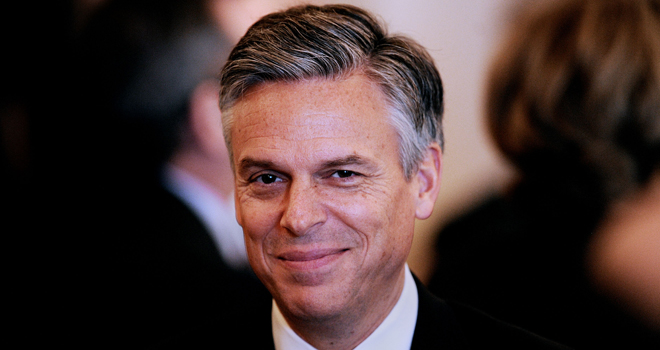Jon Huntsman is looking to reboot his flagging campaign with a new jobs plan, offering up a list of ideas to spur growth in a speech on Wednesday. But despite his recent breaks with party orthodoxy on issues like climate change, he stuck to the usual conservative line on revenue, putting tax breaks for the rich and corporations at the center of his proposal.
“I’m not running for president to promise solutions, I’m running to deliver solutions,” he said, according to prepared remarks. “Some of my entitlement reforms come directly from the Paul Ryan Plan. Other solutions come from the Simpson-Bowles Commission – a bipartisan group that last year put forth some very sensible tax reforms.”
Under Huntsman’s proposal, the tax code would be simplified into three brackets of 8%, 14%, and 23%. In addition, the corporate tax rate would be lowered to 25%, and taxes on capital gains and dividends would be eliminated entirely.
Overall, however, the whole shift would be revenue neutral. How?
The lower rates would be financed by eliminating the various tax breaks and goodies currently in the code, which account for hundreds of billions in lost revenue each year. Nothing new there. Leaders in both parties as well as several bipartisan commissions have pitched the idea of using these tax expenditures to lower individual rates and Huntsman claims his own plan is inspired by Simpson-Bowles.
But there are a few very significant, very regressive differences. While Simpson-Bowles offered up a variation of Huntsman’s plan to eliminate all tax expenditures in its final report, it didn’t actually endorse it. In fact, it went out of its way to showcase alternatives that would offer additional protection to poor and middle class Americans while asking the rich to pay just a bit more. That’s because while some of the tax expenditures out there are corporate giveaways, others are popular breaks aimed at helping the average taxpayer: examples include the earned income tax credit, the child credit, and tax exemptions for employer-provided health insurance.
Huntsman’s plan would eliminate all of them. In addition, rather than using a portion of the revenue from ending them to help pay down the deficit as Bowles-Simpson proposed, it would instead use them to eliminate the capital gains tax, which disproportionately benefits the ultra-rich. Per ThinkProgress, estimates by the nonpartisan Tax Policy Center indicate that a zero expenditure plan would add up to about $1,890 in higher taxes for middle class families while the richest 0.1% of the population would score an average $486,000 in savings from the capital gains cut.









